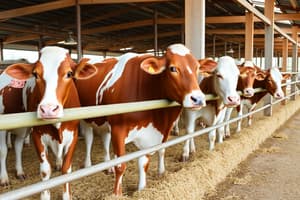Podcast
Questions and Answers
What is the main breed of dairy cattle in Australia?
What is the main breed of dairy cattle in Australia?
- Guernsey
- Ayrshire
- Holstein Friesian (correct)
- Brown Swiss
What is the estimated number of cows in the United States dairy industry?
What is the estimated number of cows in the United States dairy industry?
- 90 million cows
- 90,000 cows
- 9 million cows (correct)
- 9,000 cows
What is the most common type of feed used in dairy cattle diets?
What is the most common type of feed used in dairy cattle diets?
- Cereal grains
- Corn
- Silage
- Hay (correct)
What is the time in the cow's cycle when the female is receptive towards the male and can be detected through certain behaviors?
What is the time in the cow's cycle when the female is receptive towards the male and can be detected through certain behaviors?
What is the purpose of embryo transfer in dairy farming?
What is the purpose of embryo transfer in dairy farming?
What is the name of the hormone that is used to increase milk production and reproduction in dairy cows in the United States?
What is the name of the hormone that is used to increase milk production and reproduction in dairy cows in the United States?
What is the name of the process that involves using hormone treatments to produce multiple embryos in cows?
What is the name of the process that involves using hormone treatments to produce multiple embryos in cows?
What are some of the by-products of milk?
What are some of the by-products of milk?
What is the name of the management system used in dairy farming that depends on the climate and available land of the region?
What is the name of the management system used in dairy farming that depends on the climate and available land of the region?
Flashcards are hidden until you start studying
Study Notes
Cattle Bred for Milk Production: A Detailed Summary
-
Dairy cattle are cattle bred specifically for the ability to produce large quantities of milk, from which dairy products are made.
-
Historically, the same cattle were used for both meat and milk production, but the bovine industry is now more specialized.
-
Dairy cows may be found in herds or dairy farms where farmers own, manage, care for, and collect milk from them, or on commercial farms.
-
The United States has an estimated 9 million cows in around 75,000 dairy herds, with an average herd size of 120 cows.
-
Dairy farming can be split into intensive and extensive management systems, with the system used depending on the climate and available land of the region.
-
A dairy cow must be bred to maintain lactation, with female calves kept as replacement cows and male calves used for beef or veal.
-
The production levels of dairy cows peak at around 40 to 60 days after calving and decline steadily until milking is stopped at about 10 months.
-
The Holstein Friesian is the main breed of dairy cattle in Australia and has the world's highest productivity at 10,000 liters of milk per year.
-
Cow comfort is important for milk production, with certain behaviors such as eating, ruminating, and lying down related to cow health and productivity.
-
Feeding behaviors and rumen health are important factors for productivity, with cows with good rumen health likely to be more profitable.
-
The productivity of dairy cattle is most efficient when the cattle have a full rumen and lie down for at least five to six hours after every meal.
-
By-products of milk include butterfat, cream, curds, and whey, and the dairy industry can be divided into two market territories: fluid milk and industrialized milk.Dairy Cattle: Breeds, Reproduction, Hormone Use, Nutrition, and Animal Welfare
-
The protein from curdled cheese is used in protein bars, beverages, and concentrated powder due to its high-quality amino acid profile.
-
Artificial insemination (AI) is used at most dairy farms since the 1950s, using estrus synchronization to indicate when the cow is going through ovulation and is susceptible to fertilization.
-
Estrus is the time in the cow's cycle when the female is receptive towards the male and can be detected through certain behaviors.
-
Embryo transfer has been used to enable the multiplication of progeny from elite cows, where cows are given hormone treatments to produce multiple embryos.
-
Hormone treatments to dairy cows are administered in some countries to increase milk production and reproduction, such as the use of bovine somatotropin in the United States.
-
Forages are the most common type of feed used in dairy cattle diets, and cereal grains are important in helping to meet energy needs.
-
Ensuring adequate body fat reserves is essential for cattle to produce milk and keep reproductive efficiency.
-
Diets can be formulated to reduce methane emissions, using feed additives and supplements such as 3-nitrooxypropanol and red seaweed.
-
The seven major dairy breeds in the United States are Holstein, Brown Swiss, Guernsey, Ayrshire, Jersey, Red and White, and Milking Shorthorn.
-
Proper animal handling is crucial to dairy animals' welfare and safety, and stockmanship training is important for workers.
-
Dairy production has been criticized by animal rights proponents, citing ethical concerns regarding impregnation, separation of calves from their mothers, and culling at a young age.
-
Dairy operations include both the production of milk and the production of calves, where bull calves are either raised as steers for beef production or used for veal.
Studying That Suits You
Use AI to generate personalized quizzes and flashcards to suit your learning preferences.




